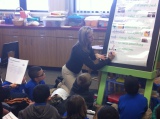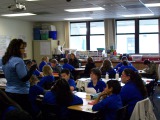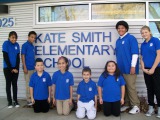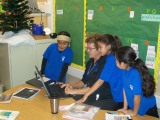-
Category 1
Selected in 2012
-
Grades: pre k - 6
School Setting: urban
Town Population: 90,264
Student Enrollment: 349
Student Demographics:
Black/African American: 4%
Teacher/Student Ratio: 1:24.8
White/Caucasian: 17%
Hispanic: 68%
Hawaiian/Pacific Islander: 2%
Asian: 5%
Native American: 1%
Other: 3%
% Reduced Lunch: 85.9%
% ELL Learners: 53.7%
Founded: 1963 -
PRINCIPAL:
Richard Swanberg -
CONTACT:
1925 F Street
Sparks, NV 89431
775-353-5720
rswanberg@washoeschools.net
Kate Smith Elementary School
Sparks, NV
Several teachers are strong proponents of the home-visit project, which encourages teachers to conduct yearly home-visits with students and families. The goal is to build positive connections between our families and school. About 40% of staff members conducted at least one home visit last year with several teachers conducting home visits with all families in their classrooms.
- Describe specific programs in place to ensure that families are involved in the success of your school and students.
- One successful program we have in place is our home visit program. Many teachers conduct home visits with families. Some teachers visit a few students while others visit every family. This is a great way to build that positive connection between home and school. Another program is our monthly parent workshops. These workshops provide information on how parents can support their students at home. Last year, workshops provided parents with reading strategies, information on assessment data interpretation, and education on how to be an advocate for your child. We also have data meetings with individual families. These meetings inform parents about student strengths and weaknesses and how we can support their child’s learning as a team. These meetings have been very valuable.
- Describe the most successful activity your school has initiated to strengthen the ties to your community.
-
Our community views our school as a resource center and that is how we have built a successful school/community partnership. We not only try to meet our students’ academic needs but also their basic needs. We are a Provision 2 school so all students qualify for free meals. To increase participation we provide breakfast in the classroom. Any child from age one to eighteen can come to our school for a free dinner. With the support of our local food bank, we provide some of our neediest families with weekly food bags.
Each year we are able to provide clothes vouchers for about 25% of our students. These vouchers allow students to purchase new clothes for the school year. Through generous donations we have the ability to provide some students with free school uniforms, shoes and other needed items. We have created a clothes closet with shoes, winter jackets, and gloves for students in need. - Describe your philosophy of school change or improvement.
- We believe there is not a simple solution to academic reform. Improvement takes hard work and the willingness to analyze school and individual classroom practices that hinder progress. Once a thorough analysis is complete, schools must be brave enough to change practices that have not been effective for several years. We all hate to fail but failing because one is unwilling to change is unacceptable.
- What are your school’s top two goals for the next year?
-
Our first goal is to implement and refine our co-teaching model within our school. With the new CCSS, all students need increased access to grade level material. As a staff, we felt a co-teaching model may meet the needs of the students more effectively.
Our second goal is to continue our understanding of the CCSS. This is a huge shift in curriculum and will have a huge impact on instruction. Teachers need to become more familiar with the standards and how the standards will impact their instruction within the classroom. - What is the single most important factor in the success of your school that others could replicate?
- We believe success starts with positive relationships. It is imperative for teachers and staff to foster positive relationships with both students and parents. Students will strive to meet their teachers’ high expectations when they know their teachers care for them not only as students but as individuals. If we lose the support of a parent, most often we lose that student. It is vital to build a trust with parents to foster academic success at home and at school.
- Describe the program or initiative that has had the greatest positive effect on student achievement.
- The two factors that had the greatest impact on student achievement were our refinement of our school’s core instruction and the implementation of our 21st Century Community Learning Center. To improve the quality of core instruction within the classroom, teachers were required to follow both the district adopted ELA and Math programs with fidelity. This structure provided students with consistency among grade level and teachers. Our after school 21st Century Community Learning Center enabled us to provide additional academic support 4 days a week for 34 weeks. On-site teachers provided extra support in reading, writing, math, and language acquisition.
- Explain how Title I funds have supported your improvement efforts.
- Title I funds have been utilized to provide extra support for students, teachers and parents. Each kindergarten teacher has a bilingual aide to support students and to help communicate with our non-English speaking parents. These aides are partially funded with Title I funds. To provide support within the classroom to assist with differentiation, a part-time intervention teacher and a long-term substitute are funded. These two positions push into classrooms to provided additional support during reading and math blocks. Additional hours are budgeted to increase the support provided by the 21st CCLC staff. Instead of 4 groups, we are able to run 6-9 groups throughout the year using Title I funds. Although we have limited funds, we do feel it is vital to support our parents. Consequently, funds have been utilized for parent engagement. One staff member receives additional contract hours to plan and provide family engagement activities during the year. After funding instructional support, any remaining funds are utilized to purchase instructional materials and technology. Each room is equipped with a Promethium board, LCD projector, Lumens, Laptop, and at least 3 student computers. Most of these essentials are funded with Title I monies.
- Identify the professional development activities you use to improve the teaching portion of the teaching and learning process.
- Each year we look for professional development opportunities that will support our students and families. PD opportunities are offered through school, district and universities. In the last 2 years, five teachers have earned their Masters degrees through a partnership between our district, the University of Nevada, Reno, and the Lemelson Foundations. The Foundation covers the cost of each participant’s tuition. These teachers have provided workshops and support to the entire staff as well as individual teachers. To better support our large ELL population, last year the entire staff was provided PD on Sheltered Instruction Observation Protocol (SIOP). SIOP strategies not only support the learning of ELL students but all students. After initial SIOP trainings, three teachers continued their ELL studies independently and earned their ELL endorsements. Another focus last year was district initiated. To reduce the achievement gap between white and non-white students, the district began a conversation about Cultural Competency. With our student population nearing 80% minority, it was a conversation our school needed to begin. Although this conversation is at its early stages, I believe it will have a large impact on our practice. We also started to focus on the transition from state standards to the Common Core State Standards. The district has provided training to the entire staff about the core shifts and also provided more in-depth training to teacher leaders on staff. These leaders share their knowledge with their Professional Learning Communities (PLC). We have also explored home-visits and family engagement activities that will enhance our relationship building capacity within our school. Several teachers are strong proponents of the home-visit project, which encourages teachers to conduct yearly home-visits with students and families. The goal is to build positive connections between our families and school. About 40% of staff members conducted at least one home visit last year with several teachers conducting home visits with all families in their classrooms.
- Describe how data is used to improve student achievement and inform decision making.
- Data is vital for both students and teachers. Teachers use both formal and informal data to adjust instruction. Data informs teachers about not only what students do not understand but also what teachers have not taught effectively. Too often we use data to determine students’ weaknesses, but not on teachers’ weaknesses. We use data to identify both. Students in grades 2-6 track their academic growth in both reading fluency and math computation bi-monthly. First grade students only track math computation data. It is exciting to hear a student say, “Hey, my math score went up.”
- Describe your school culture and explain changes you’ve taken to improve it.
-
A successful school culture starts with respect and high expectations. Over the last five years, our staff has worked tirelessly to create a safe and caring learning environment. Students know school is a safe haven for them. We are very proud that most students are eager and happy to come to school. Based on student surveys, over 90% of students feel respected and believe someone at school cares for them. We have three simple rules: Respect Yourself, Respect Your School and Respect Others. Our students strive to meet these three rules.
Expectations are also crucial to a positive school culture. We have high expectations for both students and staff. Often, teachers and schools do not have the same expectations for at-risk students. It is true that many at-risk students have barriers (language, poverty, learning disabilities, etc.) to overcome but we have the same high expectations for all students regardless of labels. They can and will learn with the right support from school.
Stats
-
Category 1
Selected in 2012
-
Grades: pre k - 6
School Setting: urban
Town Population: 90,264
Student Enrollment: 349
Student Demographics:
Black/African American: 4%
Teacher/Student Ratio: 1:24.8
White/Caucasian: 17%
Hispanic: 68%
Hawaiian/Pacific Islander: 2%
Asian: 5%
Native American: 1%
Other: 3%
% Reduced Lunch: 85.9%
% ELL Learners: 53.7%
Founded: 1963 -
PRINCIPAL:
Richard Swanberg -
CONTACT:
1925 F Street
Sparks, NV 89431
775-353-5720
rswanberg@washoeschools.net








